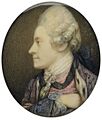Maria Cosway facts for kids
Quick facts for kids
Maria Cosway
|
|
|---|---|
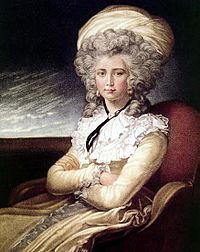
Self-portrait of Maria Cosway, 1787.
|
|
| Born |
Maria Luisa Caterina Cecilia Hadfield
11 June 1760 Florence, Italy
|
| Died | 5 January 1838 (aged 77) Lodi, Italy
|
| Nationality | Italian and English |
| Known for | Painter of portrait miniatures |
| Spouse(s) | Richard Cosway |
Maria Cosway (born Maria Luisa Caterina Cecilia Hadfield; June 11, 1760 – January 5, 1838) was a talented artist and educator from Italy and England. She worked in England, France, and Italy, making many friends and clients. She was known for her paintings and for being a lively host at social gatherings.
Maria Cosway showed her art at the famous Royal Academy of Arts in London. She also asked for the first portrait of Napoleon to be seen in England. Her artworks and prints are kept in important places like the British Museum and the New York Public Library. Her art has been shown in major exhibitions in London, including at the National Portrait Gallery and Tate Britain.
Besides being a painter, Maria was also a skilled composer and musician. She hosted many social events with her husband, the painter Richard Cosway. She had a special friendship with the American statesman Thomas Jefferson in 1786 when he was in Paris. They wrote letters to each other for many years.
Maria Cosway also founded and ran schools for girls. She started one in Paris from 1803 to 1809. Later, she opened a Catholic convent and girls' school in Lodi, Italy, which she led until she passed away.
Contents
Early Life in Italy
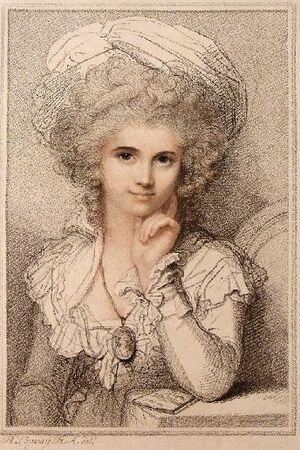
Maria was born in 1760 in Florence, Italy. Her father, Charles Hadfield, was from England and ran successful inns in Tuscany. These inns were popular with British travelers on the "Grand Tour." Her mother was Italian.
Maria was one of eight children. She showed a gift for art from a young age. She received her education at a Roman Catholic convent and remained a devoted Catholic throughout her life.
Sadly, four of Maria's siblings died when they were young. Maria, her brothers Richard and George, and a younger sister Charlotte were the only children who survived.
After her father died, Maria wanted to become a nun. However, three years later, she and her mother moved to London, England, in 1779.
Maria's brother, George Hadfield, became a famous architect. He designed Arlington House in Virginia, USA. This house later belonged to Robert E. Lee, a well-known general during the American Civil War.
Becoming an Artist
While still in Florence, Maria Hadfield studied art with talented teachers like Violante Siries Cerroti and Johann Zoffany. From 1773 to 1778, she spent time at the Uffizi Gallery, copying paintings by famous old masters. Because of her skill, she was chosen to join the Academia del Disegno in Florence in 1778.
She also traveled to Rome to study art with Pompeo Batoni. She learned from other important artists such as Anton Raphael Mengs, Henry Fuseli, and Joseph Wright of Derby.
Two women artists, Angelica Kauffman and Mary Moser, were among the first members of the Royal Academy of Arts in London. Kauffman helped Maria Hadfield show her work at the academy. In 1781, Maria exhibited her paintings for the first time. She showed three works, including Rinaldo and Creusa appearing to Aeneas. Maria became known for her paintings of scenes from myths.
Marriage and Social Life
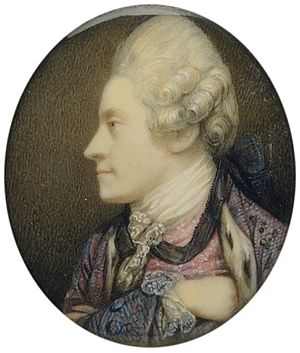
On January 18, 1781, Maria Hadfield married Richard Cosway, who was also a famous artist known for his miniature portraits. Richard was 20 years older than Maria.
At first, her husband kept Maria away from society until she became fluent in English. He also didn't want her to sell her paintings. However, he soon realized how talented she was and helped her develop her art. Over 30 of her works were shown at the Royal Academy of Art between 1781 and 1801. She became very well-known, especially after her portrait of the Duchess of Devonshire was exhibited.
In 1784, the Cosways moved into Schomberg House in London. They created a popular gathering place for London's high society. Richard was the main painter for the Prince of Wales. Maria hosted artists, royalty, and politicians like Horace Walpole. She could speak several languages and had friends from many countries, including Angelica Schuyler Church and artist John Trumbull. Maria Cosway organized concerts and musical performances for her guests. She became known as "The Goddess of Pall-Mall."
Maria and Richard had one daughter, Louisa Paolina Angelica. Maria often traveled, sometimes to France and Italy. While she was traveling, her young daughter Louisa sadly passed away.
Work in France
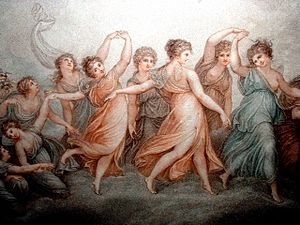
Maria Cosway made many friends in the art world around the world. She sent a print of her painting The Hours to her friend, the French painter Jacques-Louis David. He wrote back, saying it was a very clever and natural work of art. Cosway became well-known across France and had customers from all over Europe.
Maria also showed interest in French politics. In 1797, she asked artist Francesco Cossia to create the first portrait of Napoleon ever seen in England. This painting is now displayed in the Sir John Soane's Museum.
Between 1801 and 1803, Maria lived in Paris. She copied paintings by old masters from the Louvre museum to make prints in England. After her daughter's death, she did not finish this project.
Maria Cosway met Napoleon while copying his portrait by her friend David. She became good friends with Napoleon's uncle, Cardinal Joseph Fesch. During a time of peace between England and France, she gave British visitors tours of the Cardinal's art collection.
Friendship with Thomas Jefferson
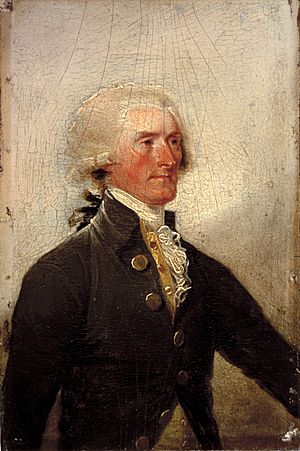
In August 1786, in Paris, artist John Trumbull introduced Maria Cosway to Thomas Jefferson. Jefferson was 43 and a widower, serving as the American Minister to France. Maria was 27. Jefferson changed his plans to spend the evening with Maria.
Cosway and Jefferson both loved art and architecture. They visited many exhibits and beautiful places together. Jefferson wrote about their adventures, describing how wonderful everything was, from the bridges and hills to the gardens and statues. For six weeks, Jefferson spent every day with Maria, and they grew very close.
When Maria and her husband returned to London, Jefferson sent her a long letter called "The Dialogue of the Head vs. the Heart." In this letter, he described a conversation between his practical side (the head) and his emotional side (the heart). He wrote about how much he missed her.
Jefferson was going through a difficult time in his life. His wife had passed away four years earlier, and he had just learned of his youngest daughter's death. Maria and Jefferson continued to write letters to each other until his death. Historians believe their friendship was very important to both of them. Before Jefferson left Paris, he wrote to her, "I am going to America and you are going to Italy. One of us is going the wrong way, for the way will ever be wrong that leads us further apart."
Cosway introduced Jefferson to her friend Angelica Schuyler Church, who was the sister-in-law of Jefferson's political rival, Alexander Hamilton. Church also wrote letters to both Jefferson and Cosway.
Both Maria Cosway and Thomas Jefferson kept images of each other. Jefferson had a print made from a drawing by Maria's husband. Maria asked Trumbull to paint a portrait of Jefferson. This painting is now displayed in the White House.
Later Life and Legacy
Maria Cosway eventually returned to Europe. She traveled in Italy with her brother George Hadfield. After her daughter's death, she returned to England and focused on painting religious pictures for churches.
Despite the war between Napoleon and England, she traveled to France. In Paris, Cardinal Joseph Fesch convinced her to open a school for young ladies, which she managed from 1803 to 1809. Later, the Duke of Lodi invited her to Italy. There, she established a convent and a Catholic school for girls in Lodi, near Milan. She led this school, called the Collegio delle Grazie, until her death in 1838.
In 1821, Cosway briefly returned to England to care for her husband before he passed away. With help from her friend Sir John Soane, she sold Richard's large art collection. She used the money to support her convent school.
In a letter to Jefferson, Maria Cosway expressed her sadness about the loss of mutual friends, including Angelica Schuyler Church. As a tribute to Church, Cosway designed a special ceiling for a temple, showing three goddesses surrounding her friend's name.
Maria Cosway spent her final years serving her school, making many improvements to the old building. She passed away in 1838 at her school in Lodi.
Art Collections
Maria Cosway's prints of old master paintings from the Louvre are part of the British Museum's collection. Two of her paintings, inspired by a poem by Mary Robinson, are owned by the New York Public Library. These paintings were shown in an exhibition at the Tate Britain museum in London in 2006.
From 1995 to 1996, the National Portrait Gallery in London held an exhibition called Richard and Maria Cosway: Regency Artists of Taste and Fashion. This show displayed 250 of their artworks.
Notable Works
Some of Maria Cosway's most important works that were shown at the Royal Academy and later made into prints include:
- Clytie
- The Descent from the Cross
- Astrea instructing Arthegal
- The Judgment on Korah, Dathan, and Abiram
- A Persian
- H.R.H. the Princess of Wales and the Princess Charlotte
- The Hours
- Lodona
- The Guardian Angel
- Going to the Temple
- The Birth of the Thames
- Creusa appearing to Aeneas
- The Preservation of Shadrach, Meshac, and Abednego
- Louis VII, King of France, before Becket's Tomb
Cosway also created a series of drawings called The Progress of Female Dissipation and The Progress of Female Virtue, published in 1800. She contributed designs to Boydell's Shakespeare Gallery and Macklin's Poets. She also etched all the plates for a large book called Gallery of the Louvre, which featured etchings of famous paintings from the Louvre museum. Many of her other prints are held by the British Library.
In Film
- Jefferson in Paris (1995) is a movie by Merchant and Ivory where Maria Cosway is played by actress Greta Scacchi.
Images for kids
-
Maria Cosway by her husband, Richard Cosway.
-
Richard Cosway's self-portrait in miniature, c. 1770
-
Engraving by Francesco Bartolozzi of Maria Cosway's painting The Hours, described by Jacques-Louis David as "ingenious"
-
Thomas Jefferson in 1788 by John Trumbull. An intimate friend, he and Maria corresponded for the rest of their lives after his time in Paris.
See also
 In Spanish: Maria Cosway para niños
In Spanish: Maria Cosway para niños




